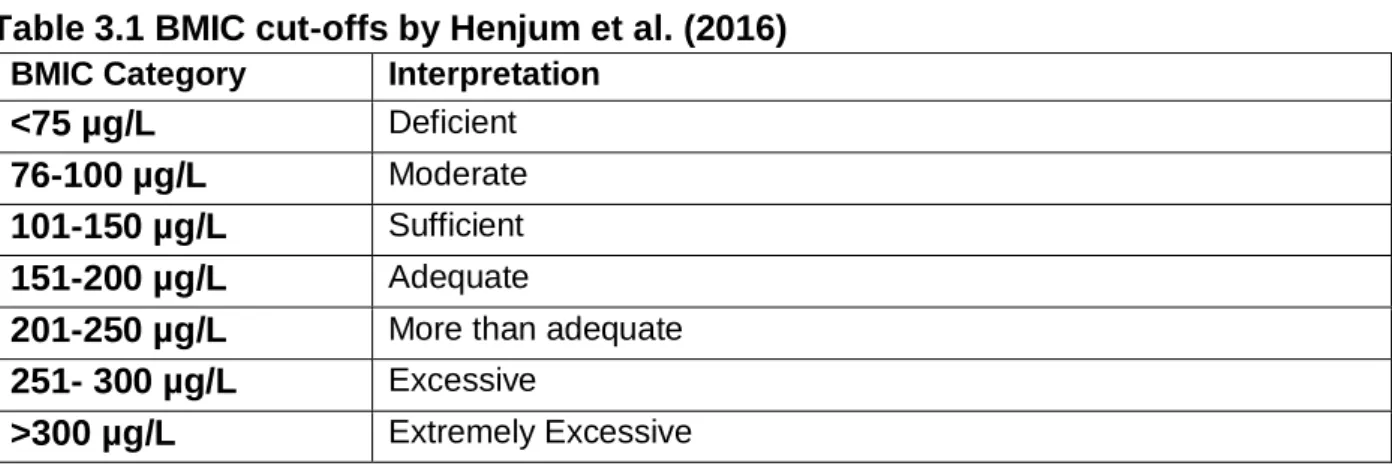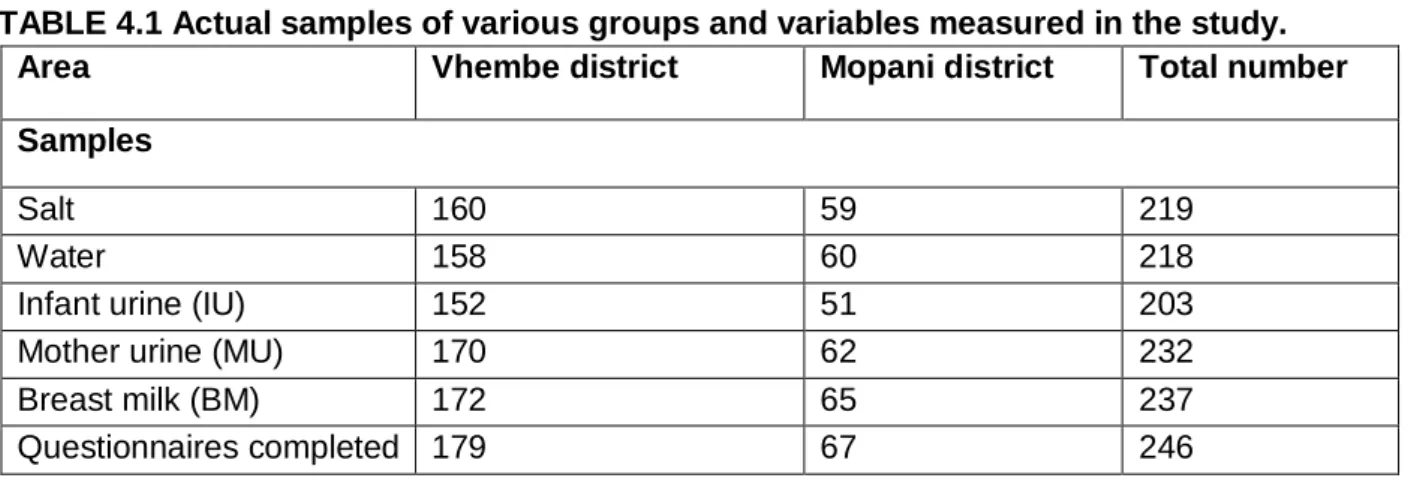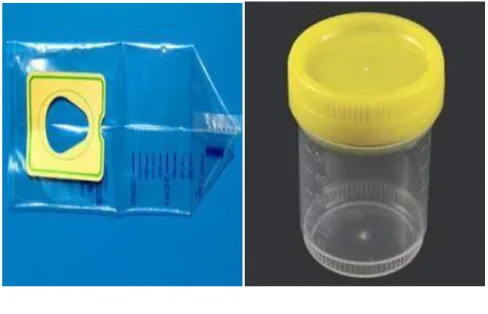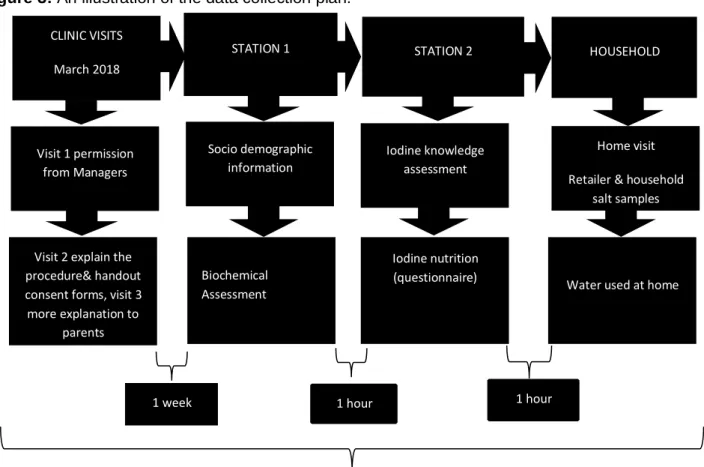All breastfeeding mothers and infants from Vhembe and Mopani District who participated in my project. Objective: The primary objective of the study was to describe the iodine status of lactating mothers and infants aged 0 to 6 months in Vhembe and Mopani districts. Conclusion: BMIC in the study indicates iodine sufficiency in both Vhembe and Mopani districts.
The results of this study suggest that the BMIC should be included in studies of iodine status in nursing mothers, as the UIC only reflects iodine recently consumed. University of Venda USA United States of America wic Water iodine content WHO World Health Organization µg/day Micrograms per day.
OVERVIEW
- BACKGROUND AND MOTIVATION
- PROBLEM STATEMENT
- AIM
- OBJECTIVES
- SIGNIFICANCE OF THE STUDY
- STRUCTURE OF THE DISSERTATION
This is because their iodine intake is based solely on the iodine concentration in the mother's breast milk. Although studies of BMIC have been conducted in other countries (Bouhouch, 2013; . Dorea, 2002; Molla, 2013), little is known about the iodine status of lactating women and infants and the concentration of iodine in breast milk in Vhembe and Mopani districts. Little is known about the iodine content of breast milk in the Vhembe and Mopani districts.
Thus, there is a need to determine the levels of iodine concentration in breast milk in these two districts in view of this gap in the literature. The aim of this study was to determine the iodine status of breastfeeding mothers and infants aged 0 to 6 months in Vhembe and Mopani districts.
OVERVIEW
- LITERATURE REVIEW
- FUNCTIONS OF IODINE IN THE BODY
- DIETARY REQUIREMENTS FOR IODINE IN THE BODY
- INDICATORS OF IODINE DEFICIENCY
- SOURCES OF IODINE
- PREGNANCY AND LACTATION
- EFFECTS OF DEFICIENCY THROUGH THE LIFE CYCLE
- Pregnancy and infancy
- Childhood
- SOMATIC GROWTH
- BREAST FEEDING AND INFANT’S IODINE STATUS
- STRATEGIES TO PREVENT OR CORRECT DEFICIENCY DURING PREGNANCY
Iodine is the essential substrate for the synthesis of the thyroid hormones T3 and T4 (Guthrine and Picciano, 1995). The thyroid hormones are iodinated amino acids released in the thyroid gland by the TSH-induced proteolysis of the iodinated thyroglubulin. It is then incorporated into the tyrosine of the thyroglobin (Tg) to form monoiodotyrosine (MIT) and diiodotyrosine (DIT).
Despite the obvious limitations of the mainly cross-sectional data included in these two meta-analyses, their overall conclusions are similar (Bleichrodt, 1994; Qian et al., 2005). Thyroid hormone promotes GH secretion and modulates the effects of GH on its receptor (Hochberg et al., 1990).
OVERVIEW
- STUDY DESIGN
- POPULATION AND STUDY AREA
- SAMPLING
- Recruitment and sample size of the study participants
- INCLUSION CRITERIA
- EXCLUSION CRITERIA
- LOCATION OF THE RESEARCH
- SUBJECT RECRUITMENT
- BIOCHEMICAL MEASUREMENTS
- Breast Milk
- Mother Urine
- Infant Urine
- SALT
- WATER
- SURVEY QUESTIONNAIRE
- PRE-TEST OF INSTRUMENT
- PILOTING
- FIELD WORKERS
- PHYSICAL ARRANGEMENTS
- QUALITY ASSURANCE
- INSTITUTIONAL APPROVAL
- ETHICAL CONSIDERATIONS
- STATISTICAL ANALYSIS
The target population was lactating mothers and infants aged 0 to 6 months in Vhembe and Mopani districts of Limpopo province. The study was conducted in clinics and health centers in Vhembe and Mopani districts. Sampling is the process of selecting a representative or part of a population (Leedy and Ormrod, 2014).
Out of 37 clinics in Mopani District, 5 clinics with the highest number of baby-mother pairs were randomly selected. We visited the selected outpatient clinics, where we explained the aims, objectives and procedures of the study to the managers of the PHC. The researcher gave the nursing mothers employment letters that explained the purposes, objectives, and procedures of the study.
The iodine concentration in human milk was analyzed in the Laboratory of Human Nutrition of ETH Zurich, Switzerland (Dold et al., 2016). The urine sample was collected between 8 a.m. and 1 p.m. and at approximately the same time as that of the breast milk collection. The questionnaire was also submitted for examination to the Research and Ethics Committee of the University of Venda.
During the pilot study, the feasibility of the project and the data collection procedures were determined. The results of the pilot study informed the researcher about the next step related to the questionnaire and the study plan. This study was approved by the Research and Ethics Committee of the University of Venda.

OVERVIEW
- SOCIO-DEMOGRAPHIC INFORMATION
- Age distribution of the mothers in the Vhembe and Mopani Districts
- Age distribution of infants in Vhembe and Mopani District
- Gender of infants in both the districts
- Employment status of mothers in Vhembe and Mopani Districts
- The participants’ household income per month
- Level of education of mothers in the Vhembe and Mopani Districts
- Mothers’ marital status in the Vhembe and Mopani Districts
- Exclusive breastfeeding of mothers in the Vhembe and the Mopani Districts
- BREASTMILK IODINE CONCENTRATION (BMIC)
- URINARY IODINE CONCENTRATIONS (UIC) OF MOTHERS
- IODINE STATUS OF INFANTS AGED 0 TO 6 MONTHS
- FREQUENCY DISTRIBUTION OF SPOT URINARY IODINE CONCENTRATIONS OF
- UIC DISTRIBUTION OF INFANTS BY AGE
- DISTRIBUTION AND CONCENTRATION OF HOUSEHOLD (HH) SALT IN VHEMBE
- Iodine concentrations of salt by appearance
- IODINE CONCENTRATION OF DRINKING WATER (WIC)
- COMPARISONS OF THE TWO DISTRICTS’ MEDIAN BY INDICATORS
- IODINE NUTRITION KNOWLEDGE
- CONSUMPTION OF FOODS CONTAINING GOITROGENS
- Consumption of cabbage and sweet potatoes by lactating mothers
The majority in Vhembe District (24.7%) and few in Mopani District were two months old when data were collected. Participants with grades 1 to 7 were 6.7% in Vhembe district and 4.5% in Mopani district. A total of 32.2% mothers in Vhembe District and 14.8% in Mopani District had a BMIC of less than 75 µg/L, indicating iodine deficiency.
The results show that UIC in Vhembe district was inadequate, while for Mopani district mothers it was adequate as recommended by WHO/UNICEF/ICCIDD. A total of 1.3% of infants in Vhembe District and 2% in Mopani District had a UIC of less than 20 µg/L. UIC for infants below 50 µg/l was 3.3% in Vhembe District and 4% in Mopani District.
Forty-one percent (41%) of the household drinking water in Vhembe District and 18.3% in Mopani District had iodine concentration of less than 10 µg/L, indicating an iodine deficiency. There was a significant relationship between the UIC of mothers and the UIC of infants in Vhembe district (r=0.354, p=0.000). A total of 37.6% of the participants in the Vhembe district and 55.2% in the Mopani district ate cabbage once a month.
Only a few participants in Vhembe district (1.1%) and 3% in Mopani district ate cabbage daily. In Vhembe District, 1.1% of participants consumed sweet potatoes daily, compared to 4.5% in Mopani District. The participants who never ate sweet potatoes were 33.7% in Vhembe district and 17.9% in Mopani district (Table 4.21).

OVERVIEW
- SOCIO-DEMOGRAPHIC INFORMATION
- BREASTMILK IODINE CONCENTRATION (BMIC)
- URINARY IODINE CONCENTRATION (UIC) OF LACTATING MOTHERS
- URINARY IODINE CONCENTRATION (UIC) OF INFANTS
- IODINE IN HOUSEHOLD SALT (SIC)
- IODINE IN DRINKING WATER
- IODINE NUTRITION KNOWLEDGE
- FOOD CONTAINING GOITROGENS
It is important to note that the unemployment rate in Vhembe (87.1%) and Mopani (97%) districts was almost three times higher than the national rate of 29.1% (Quarterly SA Labor Force Survey, 2019). More than half of the participants in Vhembe District (53.9%) and almost forty-four percent (43.9%) in Mopani District had an income of less than 3500 Rand per month. These results show that this is not the case in the two studied districts.
It can be inferred from these results that maternal UIC in Vhembe district denotes iodine deficiency and sufficiency in Mopani district. Although maternal UIC in the two districts was not significantly different (p=0.71), Vhembe had a lower UIC reading compared to Mopani. It is considered a sensitive marker of current iodine intake and may reflect recent changes in iodine status (WHO, 2013; Ma et al., 2018).
The results show that lactating mothers consume more than enough in Vhembe District and an excess in Mopani District. It is evident that the strategies used in this country to eradicate IDD are effective as Osei et al. 2018) reported excess iodine in SAC and infants. The results indicated inadequately iodized salt in Vhembe district and adequately iodized salt in Mopani district.
Nearly half of the salt samples from the HH in the districts of Vhembe (49.4%) and Mopani (49.2%) contained insufficient iodine. The results of this study suggest sufficient iodine in drinking water in the Mopani District and insufficient iodine in the Vhembe District. Iodine in drinking water can serve as an indication of the amount of iodine naturally occurring in the environment (Jooste et al., 2008).
OVERVIEW
CONCLUSION
- Iodine concentration of breast milk
- Urinary iodine concentration of lactating mothers
- Urinary iodine concentration of infants
- Salt iodine concentration
- Water iodine concentration
- Iodine nutrition knowledge
- Consumption of foods containing goitrogens
- Comparison of BMIC, UIC of lactating mothers and UIC of infants in Vhembe and
UIC for mothers in Vhembe district means iodine deficiency, while in Mopani district it means iodine sufficiency. Some of the lactating mothers in Vhembe use coarse salt and this may have contributed to iodine deficiency compared to the Mopani district. Although UIC is considered a good indicator of iodine status, the results suggest that median UIC is not an accurate biomarker of iodine intake in lactating mothers.
The UIC of infants in Vhembe districts means more than enough iodine, and in Mopani district it means excessive iodine. This can be attributed to the lack of proper monitoring and evaluation at production sites in South Africa. The salt iodine concentration of the fine salt was higher than that of the coarse salt.
The reason for this may be that coarse salt is not iodized in this country, and it is mostly consumed in the Vhembe district. Although fine salt contains a higher iodine concentration, non-iodized coarse agricultural salt remains the type most commonly consumed by households, especially in the low socio-economic communities. The lactating mothers in this study as elsewhere in the country were generally unaware of iodized salt and the dietary sources of iodine.
The consumption patterns of sweet potatoes and cabbage in the study areas did not pose a threat to the iodine metabolism of the participants. The BMIC, UIC of infants and water iodine concentration were different in the two districts. Although variations have been observed, the UIC of children shows excessive iodine, which is a problem in South Africa as no studies have been done to determine the effects of excessive iodine in the human body.
RECOMMENDATIONS
Lower salt intake does not compromise iodine status in Cape Town, South Africa, where salt iodization is mandatory. Iodine status of pregnant women and their newborns: are our children at risk of iodine deficiency. Iodine status of pregnant women and children aged 6 to 12 years fed from the same food basket in Mopani District, Limpopo Province, South Africa.
Iodine concentrations in breast milk, iodine status and thyroid function of breastfed infants aged 2-4 months and their mothers living in a South African township. The research I want to conduct for my master thesis is titled "Iodine Status of Lactating Women and Infants age 0 to 6 months in Mopani and Vhembe District, Limpopo Province". RESEARCH PROJECT: Cross-sectional study to determine the iodine status of nursing mothers and infants aged 0 to 6 months in Mopani and Vhembe District of Limpopo Province, South Africa.
The purpose of the study is to determine the iodine status of lactating women and their infants. You and your baby will not benefit directly, but the information we receive from you and your baby will help us determine the iodine concentration levels in your breast milk and you and your baby's iodine status. This information can help the Department of Health to understand your and your child's iodine status so they can make appropriate and informed decisions Contact Numbers.
The aim of this study is to determine the iodine status of nursing mothers and infants in the Mopani and Vhembe districts of Limpopo Province, South Africa. Breastfeeding mothers are required to provide their breast milk and urine for iodine status determination. Information on demographics and factors influencing iodine status will be collected through a questionnaire.
The study deals with the prevalence of iodine status in lactating mothers and infants in the Vhembe and Mopani Districts of Limpopo Province, South Africa. Iodine status of lactating mothers and infants aged 0–6 months in Mopani and Vhembe Districts, Limpopo Province, South Africa.
MOPANI DISTRICT APPROVAL LETTER







